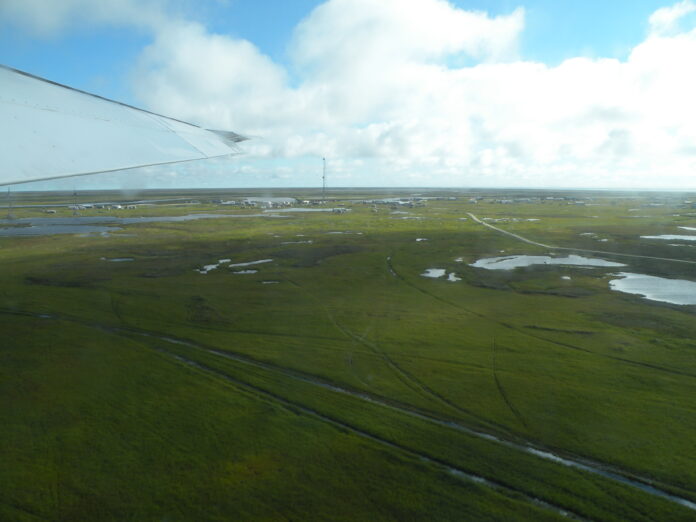The southwest Alaska community of Kwigillingok reported a sizable oil spill from its bulk fuel tank farm, which is about 500 feet from the Kwigillingok River.
The spill was discovered after the Kwik Inc. staff returned to work on Feb. 8. The diesel fuel came from a 10,000-gallon tank that overflowed. The spill was about 6,467 gallons at the latest estimate of oil that has escaped the secondary containment system. Oil was pilling at a rate of about 20 gallons a minute out of the transfer pump, which was shut off immediately upon the discovery of the spill. At this point, it appears that human error was the cause of the spill.
Kwik Inc., the village corporation, reported about 95 gallons have been recovered.
Fuel is brought into the villages before freeze-up in the fall and Kwik Inc. stores the fuel that heats the homes, school, and other buildings all winter, and powers the generators for the village’s electricity.
The Alaska Department of Environmenta lConservation, U.S. Coast Guard, and other state and federal agencies have been coordinating response efforts and staff from the agencies are on their way to Kwigillingok.
At this time, there are no reports of wildlife in the area, but this is an area that has numerous salmon streams. The spill area is frozen tundra and a small pond, but no discharge has occurred into the river. There’s very little snow on the tundra this winter.
Kwigillingok is located in a low-lying area on the Bering Sea and has been affected by coastal flooding in recent years.

Since the existence of the Denali Commission (26-years since inception), maybe they will now consider upgrading the Bulk Fuel Farm with “over-fill protection” system, possibly double wall tanks, and possibly a ‘lined’ cell with impervious liner as well as a dyke berm surrounding to house the Bulk Fuel Tanks?
Having lost 60% of your fuel by mid-February, should be of immediate concern to The Village of Kwigillingok … the operator of the power plant, and a multitude of contingency plans would // should certainly be under review and consideration, ready to implement.
As for the spill clean-up … Call ACS on the North Slope. They have the training, equipment, and ‘experienced’ know-how to help assist in this type of clean-up endeavor. You can thank the O&G Co’s for that!
It’s regrettable that this story hangs just above Dolitsky’s piece regarding economic development and coexistence with ” Traditional” uses…
Not the first time and not the last time that petroleum products have been spilled at this village. Since 1997 to 2024: approximately 400,000 gallons of petroleum products released/spilled in this area. Typically, not all releases were 100% recovered and treated. (see ADEC PPR SPILLS DATABASE search on LOCATION: Kwigillingok)
Any other federal, state, local entity with deep pockets with this long of a spill history would be under a compliance order [AS 46.03.850. Compliance Order.] with associated cleanup, groundwater and/or surface water monitoring, vapor intrusion modeling, and reporting milestones.
There appears to be ongoing regulatory discretion being exercised by ADEC Prevention Preparedness and Response Program and their commissioner who has the ultimate authority to waive further containment/cleanup action for these releases at villages such as Kwigillingok.
Not a small thing to come up with the money pay for impartial qualified third party contractor to investigate the nature and extent of contamination as well as any risk evaluation modeling and potential cleanup actions – after the ongoing emergency situation is addressed.
18 AAC 75.310. Scope and duration of initial response actions.
“… Commissioner as appropriate
(1) determines, in consultation with appropriate agencies as provided in AS 46.04.020(a)(1) or AS 46.09.020(a)(1), that containment or cleanup of the discharge or release is technically not feasible; or
(2) determines that the containment or cleanup effort would result in a greater threat to human health, safety, or welfare, or in greater damage to the environment than the discharge or release itself.”
AK Fish: Perhaps you would like to check your work? I looked at the database you mentioned and filtered for the village of Kwigillingok and as far as I can tell, your ‘approximation’ is off by 390,582 gallons. Also, I gave you benefit of doubt and included all types of spills of all listed substances.
Listed in the database are a total of 17 spills totaling 9,418 gallons.
Are they going to be fined like a spill by the big bad oil company’s?
My bet is a slap on the hand.
My bet is no slap, maybe a “stern” lecture. But, some people would call that racist.
Better force the village to go on renewable energy right now!
Oh wait, only the road system gets subjected to mandates like that.
Close to the mouth of the Kuskokwim River that leads up to Bethel. Why was fuel being pumped when no one is around to supervise it? Error possibly. Sure makes a good argument for getting rid of fuel and going green doesn’t it? How many more fuel/oil spills or explosions are we going to see in the coming months out in the villages?
Wow, so they pumped heating oil onto the ground at a rate of 20 gallons a minute and nobody noticed for 5 and a half hours? This is pretty clearly negligence and yet, almost certainly no person or organization will be held accountable in any manner.
Who paid for this fuel, and who will pay for the cleanup and replacement of the lost fuel?
I think that we know those answers.
A home brew party waits for no one apparently, including the guy who’s supposed to turn off the spigot.
What do they care? They didn’t pay for it nor do they have to clean it up. It’s like we have 229 villages filled with just 5 year olds.